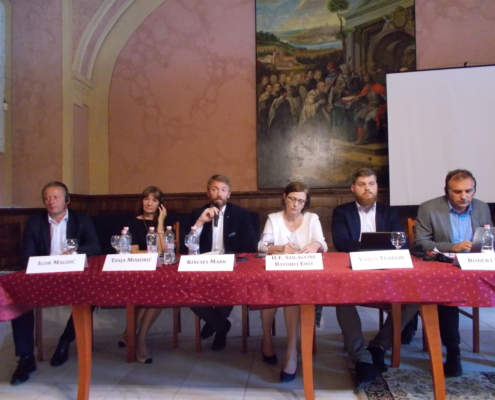4th Slovene – Hungarian Forum
On the 18th of June 2018 the two embassies, the Municipality of Szentgotthárd and the Central European Service for Cross-border Initiatives organized the fourth Slovene-Hungarian Annual Forum with the aim to strengthen the professional relationship between the stakeholders of the two countries and to establish shared developmental initiatives.
As Boris Jesih, Consul General of the Republic of Slovenia said: “the forum gives us the opportunity to learn from each other and to realize that we are not so different from each other”. So far the most significant result of the initiative is the agreement signed on the 26th March 2018 on the development of self-driven cars between Hungary, Slovenia and Austria, which was founded by the Palkovics-Koprivnikar meeting during the third forum.
The substantial program was opened by Gábor Huszár, Mayor of Szentgotthárd, Dr. Aleksandra Pivec, State Secretary of the Government’s Office for Slovenians Abroad and Dr. Péter Szilágyi, Deputy State Secretary of the Prime Minister’s Office.
During the morning, the speakers and contributors of the three plenary sessions elaborated on the challenges and opportunities of economic and social development of peripheral areas through agriculture and the environment, aging society and capacity building, education, mobility and tourism. After lunch, the three sections covered the possibilities of cooperation and development in the cross-border region.
Deputy State Secretary Péter Szilágyi emphasized the importance of the 929 million HUF development program in Prekmurje in the development of the peripheral area. According to the plans, the M70 motorway is due to be completed by the end of 2019 and two new border crossings will be opened reducing the average crossing distance to 8.5 km.
The most innovative area of the Hungarian-Slovenian cooperation is the automotive industry. Peter Lukács, an expert of the Ministry of Innovation and Technology, drew attention to the joint initiative on self-drive cars. In addition, he emphasized the role of Koper in sea shipping to Hungary: 70% of the container transport to Hungary arrives via the Slovenian port. For these a primary logistics base will be built in Zalaegerszeg. Tanja Mohorič, managing director of the Automotive Cluster of Slovenia added that one of the main innovations in the Slovenian automotive industry is the development of electric cars’ on-the-go charging, which will also be tested on the Zalaegerszeg track.
Another mentioned joint development opportunity was the construction of the Zalaegerszeg-Rédics-Lendva railway line, which is on the agenda. Erika Kissné Köles, Spokesperson of the Slovene Nationality in Hungary, however, drew attention to the fact that, according to the Hungarian plans the M8 will be built only as a road with two lanes which will not improve the isolation of Porabje.
In the field of agriculture, relations between the two neighboring countries are also strengthened. Máté Tömösváry, a trade manager (Balaton Ker-Tész Association), said they had attended the Maribor International Fair last year which already resulted in orders from Slovenia. Niko Miholič, director of Panorganic Ljutomer, plans to build a greenhouse in the area of Szentgotthárd as more and more vegetables (mainly salads) are in demand in Hungary.
Jože Gricar, a member of the CESCI presidency, retired professor at the University of Maribor announced a new area of cooperation: the Slovenian e-Seniors initiative aims to involve the elderly in the new world of the digital revolution. The professor invited the participants in the autumn in Ljubljana for the conference to be held on this topic and to the international network that is being formed.
Dr. Robert Celec, director of Mansion Rakić, one of the main drivers of cross-border tourism cooperation was able to report on a number of joint projects. He emphasized that the tourism actors in the border region seem to be competing for one another, but in reality they have to overcome this competition as for instance from Hamburg this border region seems to be only a small part of a much larger destination.
During the afternoon sessions the participants discussed the conditions of cross-border cooperation. In this session the national representatives of the two national minorities, the mayors and farmers of the region and the management of MURABA EGTC (an EGTC registered in Szentgotthárd in August 2017) were involved. Erika Kissné Köles erred at the fact that since 1993 no map shown Porabje where a total of 10,000 Slovenians live. She also pointed out that without the economic support of the mother countries these small-scale communities cannot survive.
In the final panel, the European Grouping for Territorial Cooperation (EGTC) was identified by the participants as an effective tool for developing the border area and preserving national traditions.
As László Göncz, parliamentary representative of the Hungarians in Slovenia, summarized the main message of the forum: “The border did not disappear: it remained in the heads. The challenge is to be able to create a region where we can live in a multicultural system also in 2100, preserving both cultures and languages”. At the closing of the event, Ambassador Szilágyiné Bátorfi Edit, Metka Lajnscek deputy ambassador and Gábor Huszár mayor highlighted the importance of the Szentgotthárd – Monošter Initiative in this process and encouraged active participation in the 2019 Forum.




